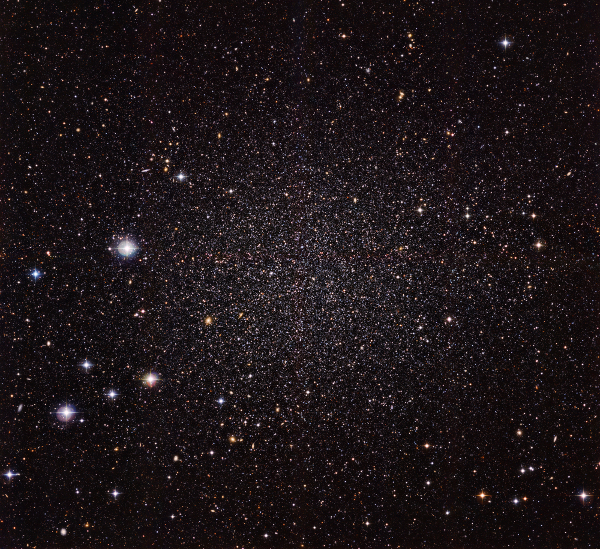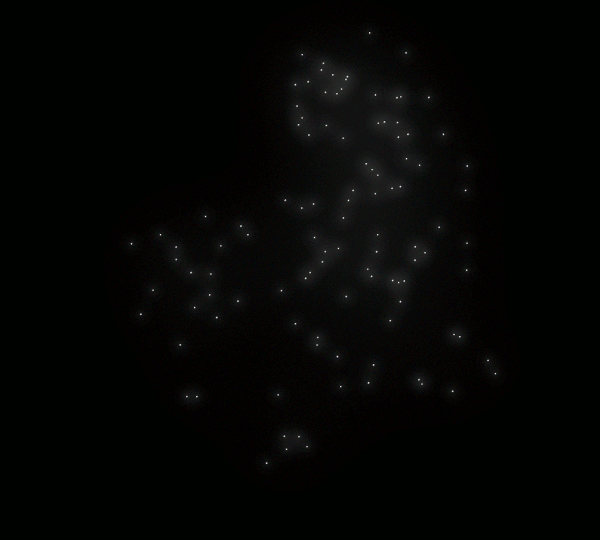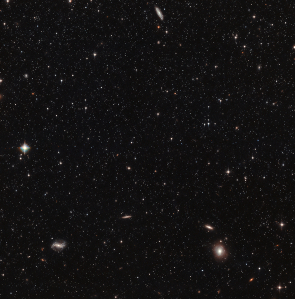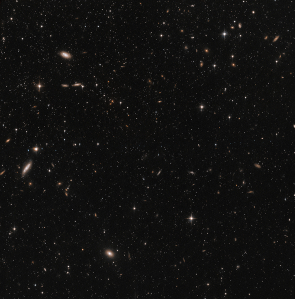Stellar motions in nearby galaxy hint at underlying dark matter
27 November 2017
By pinning down, for the first time, the three-dimensional motions of individual stars in the nearby Sculptor dwarf galaxy, astronomers have shed new light on the distribution of invisible dark matter that pervades the galaxy. This study combined the positions of stars measured by ESA's Gaia mission with observations from the NASA/ESA Hubble Space Telescope taken twelve years earlier. |
| Sculptor dwarf galaxy. Credit: ESO |
Our Milky Way galaxy, home to hundreds of billions of stars, is orbited by more than a dozen smaller satellite galaxies. The best known in this swarm, the Large and Small Magellanic Clouds, are visible with the naked eye from middle and southern latitudes, while the others are much fainter and can only be observed with the aid of telescopes.
These satellite galaxies are classed as dwarfs, since they contain only a small fraction of the stars hosted in regular galaxies. They are all engaged in gravitational interactions with the Milky Way, and these dynamical processes might leave telltale traces in their shape.
Astronomers have been studying stars in dwarf galaxies for decades, striving to reconstruct their origin and to uncover the past history of our Galaxy and its environment.
A new study has now brought one of these galaxies, the dwarf Sculptor, into unprecedented focus.
"For the first time, we've been able to determine how individual stars are moving through a dwarf satellite of our Milky Way," says Davide Massari from Kapteyn Astronomical Institute in Groningen, The Netherlands, who is lead author of the paper published today in Nature Astronomy.
"This was possible by combining the exceptionally accurate measurements of stellar positions from Gaia's first data release with equally outstanding observations taken over twelve years earlier by the Hubble Space Telescope."
 |
| Exaggerated view of the minuscule motions of stars in Sculptor dwarf galaxy. Credit: ESA/Gaia; ESA/Hubble, NASA; D. Massari et al. (2017) |
As expected, the shifts in the star positions as observed on the plane of the sky – called proper motions – are tiny, even over the long time baseline between 2002, when the Hubble observations were performed, and the first set of publicly released Gaia data, gathered between 2014 and 2015.
"We couldn't wait to see whether the Gaia observations could be used to measure individual proper motions in another galaxy, so we were thrilled to see this was indeed possible," says Amina Helmi, a co-author of the study, also based at Kapteyn Astronomical Institute in Groningen.
Massari, Helmi and colleagues measured the proper motions of roughly a hundred stars in the Sculptor dwarf galaxy. For a smaller subset of ten stars, chosen among those with the smallest errors, the astronomers could also retrieve from the literature an estimate of the radial velocity, which quantifies the stellar motion along the line of sight.
Using the proper motion and radial velocity measurements, they were able to reconstruct how these stars move in three dimensions – the first time this was done for a dwarf galaxy.
Previous studies of stellar positions in this and other dwarf galaxies had enabled astronomers to determine the overall motion of these satellites around the Milky Way.
 |
| Hubble view of a small field in the Sculptor dwarf galaxy (pointing 1). Credit: ESA/Hubble, NASA, CC BY 4.0 |
 |
| Hubble view of a small field in the Sculptor dwarf galaxy (pointing 2). Credit: ESA/Hubble, NASA, CC BY 4.0 |
"Our study went beyond: joining these two exceptional data sets, we could for the first time extract information about both the dwarf galaxy's motion and about the motions of stars within it," explains Massari.
Stellar motions are especially useful because these can lead astronomers to something they cannot see: dark matter, an invisible component that is vastly more abundant than ordinary matter across the cosmos.
Still elusive to direct detection, the presence of dark matter can be inferred by its gravitational effect on the motion of other objects, like stars or galaxies.
"Dwarf spheroidal galaxies like Sculptor are some of the most dark matter dominated objects we know of in the Universe," says Helmi. "It's in these places that we can really 'see' this mysterious component at play."
The new data indicate that stars in the Sculptor dwarf galaxy move preferentially on elongated radial orbits. This is consistent with the distribution of dark matter in the galaxy being 'cuspy', meaning that its density increases towards the centre instead of flattening out.
"Cuspy profiles are predicted by simulations of the large-scale distribution of dark matter within the standard cosmological scenario, and our new results are definitely in agreement with that," adds Helmi.
While the findings seem promising, the data sample used in this study is not very large, and more data are needed to place stronger constraints on the dark matter distribution in this galaxy. Even though Gaia has measured thousands of stars in the field of Sculptor, in this study the astronomers could only determine the proper motions for those that had also been observed by Hubble, which looked at two small patches within the broader galaxy field.
Gaia, on the other hand, has been scanning the entire sky. As its operations are continuing, the astronomers are looking forward to the larger, more precise data sets that will be released in future years.
The second data release, based on data collected between 2014 and 2016 and planned for April 2018, will not only contain exquisitely accurate positions of more than one billion stars, but also proper motions. This release will not provide proper motion measurements for stars in dwarf galaxies like Sculptor with sufficient precision to investigate the motions of individual stars, but the measurements will be precise enough to study the bulk motion of the galaxy.
"The second Gaia data release can be used to accurately pin down the overall motion of Sculptor around the Milky Way, and measure the motion of other dwarf galaxies, too, to unprecedented precision," says Anthony Brown from Leiden University in The Netherlands, chair of the Gaia Data Processing and Analysis Consortium (DPAC) and a co-author of the paper.
"But it's the final release, based on several years of Gaia observations, that will reveal the individual proper motions of thousands of stars in the satellites of our Milky Way."
Last week, ESA approved an extension of Gaia operations for an additional 18 months, so it will keep scanning the sky until at least 2020. One of the key science drivers for the extension was the study of proper motions of stars in dwarf galaxies, which requires observations taken over as long a time baseline as possible.
"With Gaia, we are looking at our Galaxy and its neighbours 'in action', delving into the motions of stars, and unveiling their secrets," says Timo Prusti, Gaia project scientist at ESA.
"This study provides us with an amazing preview of the exciting science that can be done with the full Gaia catalogue."
Notes for Editors
"3D motions in the Sculptor dwarf galaxy as a glimpse of a new era" by D. Massari, et al., is published today in Nature Astronomy.
For further information, please contact:
Davide Massari
Kapteyn Astronomical Institute
University of Groningen
The Netherlands
Email: massari![]() rug.astro.nl
rug.astro.nl
Amina Helmi
Kapteyn Astronomical Institute
University of Groningen
The Netherlands
Email: ahelmi![]() rug.astro.nl
rug.astro.nl
Anthony Brown
Leiden Observatory
University of Leiden
The Netherlands
Email: brown![]() strw.leidenuniv.nl
strw.leidenuniv.nl
Timo Prusti
Gaia Project Scientist
European Space Agency
Email: timo.prusti![]() esa.int
esa.int




